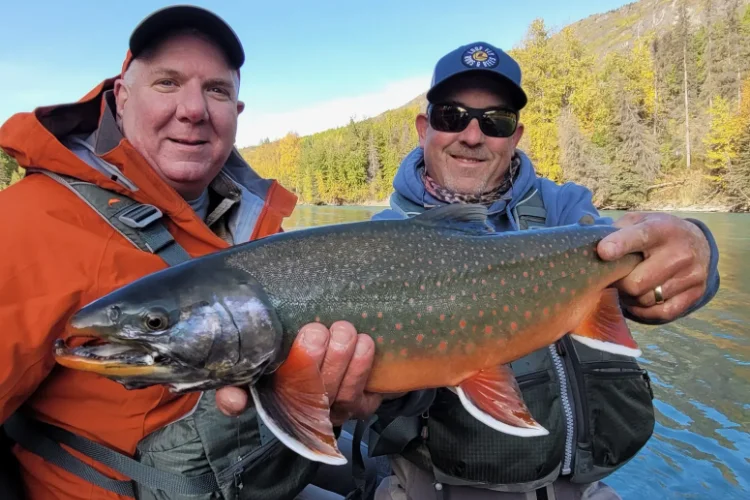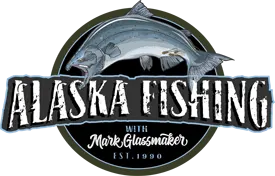
Kenai River
Dolly Varden Fishing Trips

We offer both full- and half-day fishing trips for Kenai River Dolly Varden. These trips closely resemble our Kenai River Rainbow Trout excursions, as Dolly Varden share similar feeding habits and habitat preferences. Renowned for their appetite for loose salmon spawn, these fish are prolific egg eaters. The most effective way to catch them is by dead drifting beads. Dolly Varden fishing is essentially open year-round, but the best action aligns with the various salmon spawning periods. The fall months are by far the most productive, as dollies take full advantage of the abundant salmon eggs in the river.
Kenai River Dolly Varden Fishing
The Kenai River has an abundant population of Dolly Varden, one of the most diverse and mysterious sportfish in all of Alaska. The Kenai River Dolly Varden population includes both resident species as well as the sea-run variety. Technically, Dolly Varden are not a trout but are a subspecies of Arctic Char. These popular sportfish spawn in the late fall and exhibit some of the most spectacular spawning colors on any fish in the state.
Where we fish for Kenai River Dolly Varden
Much like rainbow trout, Kenai River Dolly Varden are highly migratory and occupy different areas of the Kenai River according to where the most food is available. Early and mid-season we will cover much of the middle river in search of the best dolly varden fish and they will be feeding on out migrating salmon smolt, aquatic insects as well as left over salmon flesh from the previous season. As we enter the fall months, Kenai River Dolly Varden will congregate behind spawning salmon and feed on loose single eggs. Much of this fall feeding activity will take place in the Kenai National Wildlife Refuge below Skilak Lake.
Kenai River Dolly Varden Limits
The limit for dolly varden on the Kenai River is one fish per day under 16 inches. The majority of Kenai River anglers targeting dolly varden practice catch and release as dollies are primarily resident species and do not all die each season like salmon. The health of their overall population and their ability to reach trophy sizes depends on responsible catch and release practices.
Kenai Dolly Varden Fishing Rates
June / July / August / September / October
Kenai Half Day – $295pp
Up to 5 hours
Kenai Full Day – $350pp
Up to 8 hours
Upper Kenai Full Day – $450pp
Up to 8 hours
Private Charter (especially recommended for fly fishing trips) – $1,000 ( 2 person max )
Up to 8 hours
Things To Know About Kenai River Dolly Varden:
*Spawning Season & Conditions: Dolly Varden (Salvelinus malma), a species of char, are fall spawners in Southcentral Alaska, typically reproducing in late September or October. The females create redds (gravel nests) in which they deposit between 600 and 6,000 eggs, depending on their size.
Spawning is a highly demanding process for these fish, and a significant portion of the population does not survive afterward. Studies estimate that about 70% of the males and up to 60% of the females die post-spawning. This high mortality rate is due to the energy expended during migration, courtship, and reproduction, as well as increased vulnerability to predators and environmental stress. However, those that do survive may spawn multiple times over their lifespan.
Dolly Varden exhibit both anadromous (migratory) and resident (non-migratory) life histories. Anadromous individuals travel between freshwater and saltwater, while resident populations remain in freshwater year-round.
*Hatching & Emergence: Young dolly varden emerge from the gravel in early spring months of April and May. They depend initially on their attached egg yolk before eventually transitioning to aquatic insects and small fish for their prey.
*Age, Growth, and Maturity: Most dolly Kenai River dolly varden spend 2-3 years in the freshwater before making their first journey to the ocean. When transitioning to their ocean environment, dolly varden loose their par marks and become more silver in appearance. Some Kenai River dolly varden do not migrate to salt water but rather over winter in both Kenai and Skilak Lakes. With a lifespan of up to ten years, Kenai dollies spend the majority of their adult lives in a mysterious migration between fresh and saltwater environments as they follow various abundant food sources.
How we fish for Kenai River Dolly Varden
Dolly Varden bite all the same lures, bait and flies that Kenai Rainbows do. Dead drifting single egg patterns, flesh flies, as well as swinging flies such as intruders and dolly llamas are all effective. In the spring, fishing aquatic insect patterns such as nymphs and small stone flies will yield good results. Dolly Varden also feed heavily upon out-migrating salmon so smolt patterns in the spring should not be overlooked. During the fall months, Kenai River Dolly Varden congregate behind spawning salmon and feed on loose single eggs. Beads and other single egg patterns are top producers in the late season.

FAQ’s About Dolly Varden Fishing
Where to catch Dolly Varden in Alaska?
What is the best bait for Dolly Varden?
What is the limit on Dolly Varden in Alaska?
Is Dolly Varden good to eat?
More Information on Kasilof River Trout Fishing
These pictures are taken from our riverside property using a panoramic camera to capture both upriver and downriver views. We hope you enjoy seeing how different the river looks at different times of the year. March 10, 2019 January 2, 2019 February 2, 2018 October 1, 2017 May 30, 2017 May 4, 2017 April 14, 2017 …
The Kasilof River, known as the “little brother of the Kenai”, is located just south of the Kenai River by 11 miles and is slightly smaller in size. It begins at Tustamena Lake, the largest Lake on the Kenai Peninsula and flows northwest for 17 miles before dumping into Cook Inlet. The Kasilof is considerably …
JANUARY 2007 KENAI RIVER ICE FLOOD DELIVERS A WALL OF ICE…OVERNIGHT! As many of you may remember, the Kenai River witnessed a rare and powerful midwinter flood in January 2007. It occurred essentially overnight after a large lake in its glacial headwaters released its contents under the weight of its own ice cap. The result was …
Alaska Dolly Varden Fishing. Dolly Varden, Salvelinus malma, malma is actually a subspecies of an anadromous member of the salmon family, and is technically a char. The Kenai river supports both anadromous (those that travel to salt water) and lake populations of dolly varden char. Once thought to be a predator of salmon eggs, studies have shown that dollies …
Here is another good read covering the latest information on king salmon management… https://www.alaskadispatch.com/article/new-tools-biologists-aim-avert-another-kenai-king-disaster
For those of you keeping up with the latest discussion regarding our king salmon returns, here is an excellent article that summarizes the Cook Inlet Task force meeting and proposals to date. It is important to remember that ultimately this all comes down to making sure we preserve what is arguably the most genetically unique king …
